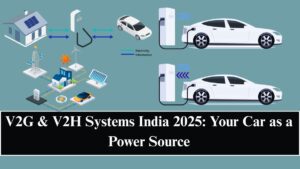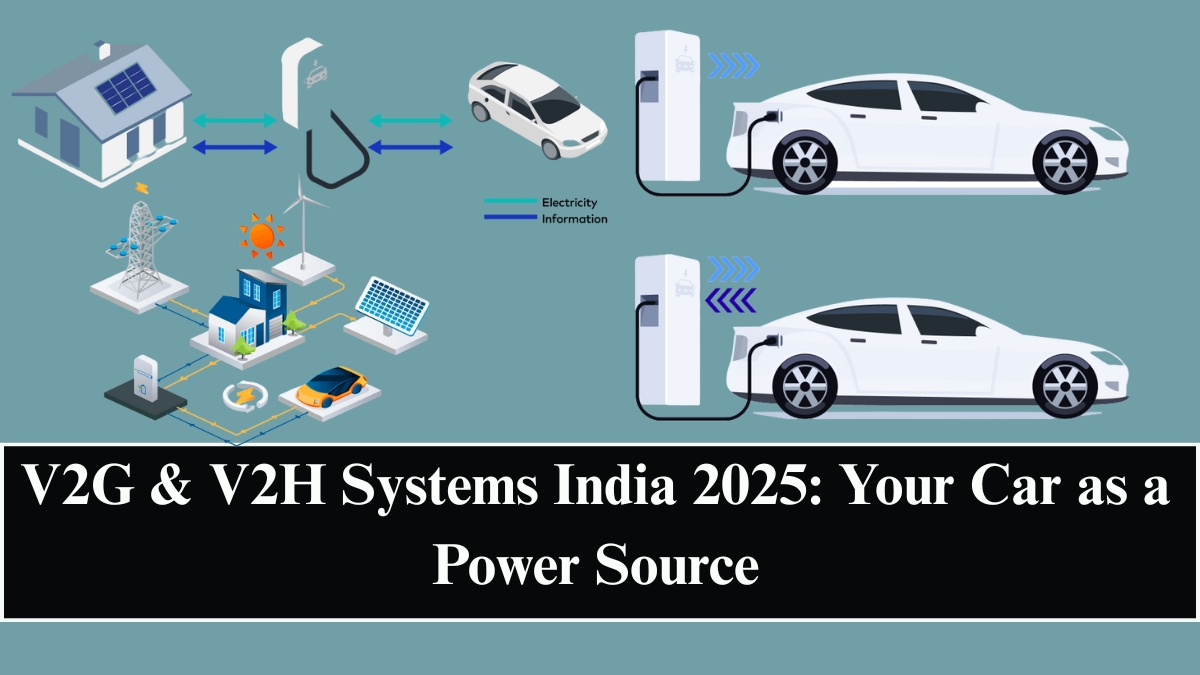In 2025, India’s electric revolution is entering a new phase where cars don’t just consume power — they generate and share it. With V2G & V2H Systems India 2025, electric vehicles are becoming mobile power units, capable of sending electricity back to the grid or powering homes during outages. This innovation is reshaping how India views mobility, energy storage, and sustainability all at once.
As the country expands its EV ecosystem, Vehicle-to-Grid (V2G) and Vehicle-to-Home (V2H) technologies are emerging as the bridge between clean mobility and renewable energy integration.

Understanding V2G and V2H Technology
At their core, V2G and V2H systems rely on bidirectional charging — allowing electricity to flow both into and out of an electric vehicle’s battery.
-
V2G (Vehicle-to-Grid): EVs send stored electricity back to the national power grid during peak demand hours, helping balance energy loads.
-
V2H (Vehicle-to-Home): EVs act as backup energy sources for homes, powering essential appliances during blackouts or high tariff periods.
This concept transforms EVs from mere transport devices into distributed energy resources (DERs), making them integral to India’s future energy strategy.
India’s Progress in Bidirectional Charging Infrastructure
In 2025, India’s major automakers, power companies, and policymakers are accelerating efforts to deploy bidirectional EV chargers compatible with V2G and V2H functions.
Companies like Tata Power, Exicom, Delta Electronics, and ABB India have introduced CHAdeMO and CCS2-based bidirectional chargers that enable real-time energy exchange. Meanwhile, smart grid projects led by NTPC, BHEL, and EESL are running pilot programs integrating EVs with renewable energy sources such as solar and wind.
Cities like Delhi, Pune, Bengaluru, and Hyderabad have become testing grounds for smart charging stations capable of balancing grid loads while offering users incentives for contributing power during peak hours.
The Benefits for EV Owners and the Grid
For EV owners, the benefits of V2G and V2H systems go beyond convenience. By exporting unused power from their car batteries back to the grid, owners can earn credits or payments from utility companies. This turns EVs into income-generating assets.
At the grid level, thousands of EVs connected via V2G can stabilize power fluctuations caused by renewable energy variability. During solar or wind downtimes, stored EV energy helps maintain consistent supply — making the entire power system more resilient and sustainable.
In rural areas, V2H technology is proving valuable for households with unreliable grid connections, allowing families to use stored EV power to run fans, lights, or even small refrigerators during outages.
Automakers Embracing Energy-Car Integration
Automakers in India are quickly adapting to this emerging trend. Tata Motors, Hyundai, and MG Motor India are working on EV platforms with integrated bidirectional inverters, while Nissan and Honda are showcasing global V2G-ready models.
The new Tata Nexon EV 2025 edition, for example, features optional bidirectional charging support, allowing home energy backup via a compatible wall box. Similarly, Hyundai’s IONIQ 5 and Kia EV6, already available in India, demonstrate the power of vehicle-to-load (V2L) — the first step toward full-scale V2H integration.
Policy and Standardization Efforts in India
To make V2G and V2H scalable, India’s policymakers are working toward standardized communication protocols, energy tariffs, and safety norms. The Bureau of Energy Efficiency (BEE) and Central Electricity Authority (CEA) are framing guidelines to regulate energy exchange between EVs and the national grid.
The FAME-II and National Electric Mobility Mission have started including pilot incentives for bidirectional charging equipment, encouraging manufacturers and charging networks to invest in this technology. Once standardized, V2G will play a major role in supporting India’s ambitious 500 GW renewable energy target by 2030.
The Road Ahead: Turning Cars into Power Hubs
By 2025, V2G and V2H technologies are moving from pilot projects to early adoption. As more EVs become bidirectional-ready, India’s smart grid will transform into a dynamic, decentralized energy network where vehicles, homes, and power plants coexist seamlessly.
The future of energy and mobility lies in their convergence — and V2G & V2H Systems India 2025 are the key catalysts driving that transformation. In the coming decade, every parked EV could double as a clean, connected power hub — helping India transition toward a more sustainable, self-reliant energy ecosystem.
FAQs
What is the difference between V2G and V2H?
V2G allows electric vehicles to send energy back to the power grid, while V2H lets vehicles power homes or small appliances directly during outages or peak hours.
How can EV owners benefit from V2G in India?
EV owners can earn credits or payments by supplying excess battery power to the grid, helping balance demand while reducing electricity costs.
Are V2G and V2H technologies available in India?
Yes. Pilot programs are already active in cities like Delhi, Pune, and Bengaluru with support from Tata Power, NTPC, and several automakers.
Which EVs in India support bidirectional charging?
Models like the Tata Nexon EV 2025 edition, Hyundai IONIQ 5, and Kia EV6 support bidirectional charging features compatible with V2L and V2H systems.
What is the future of V2G in India?
By the late 2020s, India aims to establish a nationwide V2G framework integrated with renewable grids, enabling large-scale energy exchange from EVs to the power network.
Click here to know more.
